Bloat is no joke, and the stakes are higher when you’re dealing with larger breeds. So, grab a cup of coffee, get cozy, and let’s chat about how we can proactively ensure our big buddies steer clear of this deadly condition! No fluff, just the stuff that matters.
In this topic, I’m covering 5 ways to prevent bloat in big dogs.
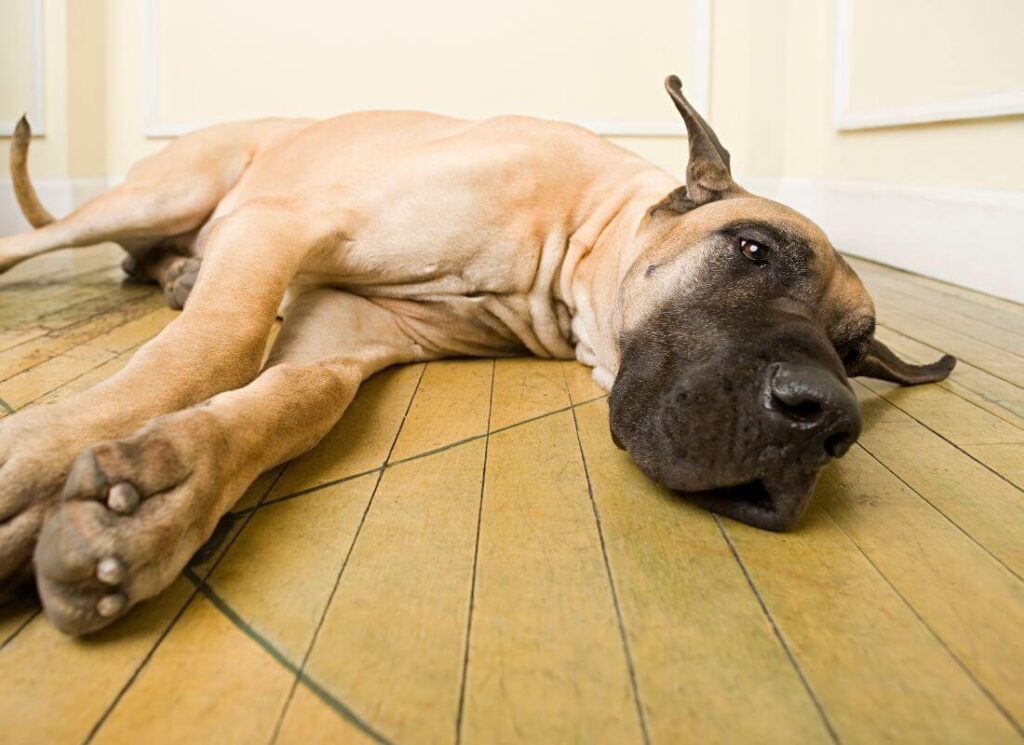
What is Bloat in Dogs?
Bloat, scientifically known as gastric dilation and volvulus (GDV), is like the canine version of a stomach nightmare. Picture this: your big, lovable goofball is happily going about the day when suddenly, things take a twist – literally.
The stomach fills up with gas, fluid, or air, causing it to swell like a balloon. That’s not even the worst part. That inflated stomach can twist on itself, cutting off blood supply and playing havoc with your pup’s well-being and internal organs.
It’s a serious medical emergency, and our oversized companions are particularly prone to it.
It is believed that around 20% of dogs over 100 lbs will experience this in their lifetime. That’s 1 in 5!
So, in a nutshell, bloat is the kind of party we want to avoid in the doggy digestive system. Stay with me, folks – we’re just scratching the surface.
What Are The Signs that a Dog is Bloating?
If you are at all concerned that your dog is bloating, you must visit a veterinarian ASAP. Mere minutes can be the difference between life and death, even if your pet has had a gastropexy (more on this later).
Here are the signs of bloat in dogs:
- Swollen Belly: Keep an eye out for a rapidly expanding midsection, a sure sign something’s amiss.
- Unproductive Vomiting: If Fido’s trying to vomit but nothing’s coming up, it’s a red flag.
- Restlessness: Excessive pacing, unable to find a comfy spot – a sign of discomfort.
- Excessive Drooling: More slobber than usual can signal a problem in the belly department.
- Difficulty Breathing: Labored breathing or rapid panting – breathing should never be a struggle.
- Pale Gums: Check those gums – if they’re losing color, it’s time to act fast.
- Collapse: In severe cases, your buddy might collapse – an emergency.
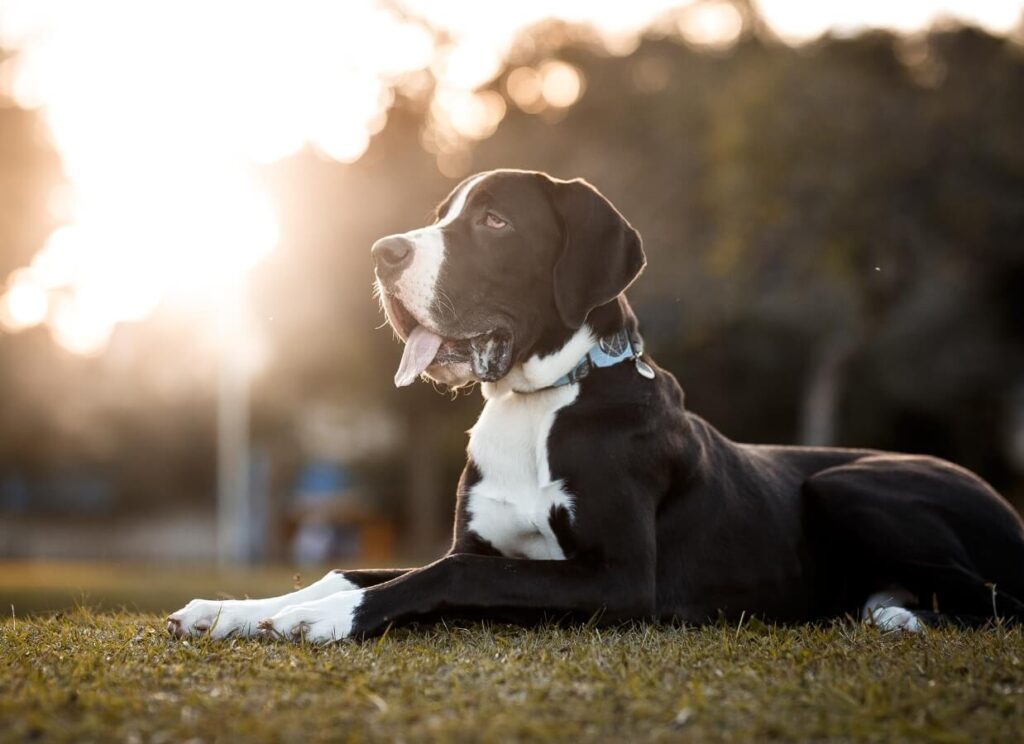
1. Keep Your Pup Happy to Prevent GDV
Statistically speaking, anxious, nervous, and aggressive dogs are more likely to bloat. Regarding the risk of bloating in our colossal canines, temperament plays a surprising role.
Why is this? A confident pet tends to keep the digestive system in harmony, while the anxious types might unknowingly set the stage for gastric drama.
Think about a time when you were nervous. Did you get the classic symptoms of “bubble gut”? Anxiety causes digestive issues in humans and pets!
Anxious, fearful, and aggressive dogs tend to gulp their meals down. This is a form of stress that may increase their risk of bloat.
Here are some common sense ways to reduce stress, anxiety, and aggression in your pet:
- Choose Good Breeders: Temperament is largely genetic. Nervous, flighty, anxious, and aggressive dogs often receive these traits from their parents.
- Routine Rules: Dogs love a schedule. Stick to regular feeding times, walks, and play – predictability is their happy place.
- Cozy Safe Spots: Create a haven where your pet can retreat when the world feels overwhelming. A comfy bed or cozy corner works wonders.
- Exercise Galore: A tired dog is a happy dog. Regular walks and playtime help burn off excess energy and keep anxiety at bay.
- Positive Reinforcement: Reward good behavior with treats and affection. Positive reinforcement goes a long way in building a chilled-out attitude. Ditch the outdated intimidation-based training methods that instill fear.
- Gentle Introductions: Socialize smartly. Gradual introductions to new people, pets, and environments can prevent stress-triggered meltdowns.
- Mind Games: Keep those brains buzzing with puzzle toys and games. Mental stimulation is a secret weapon against boredom-induced anxiety.
- Consistent Rules: Be clear on the rules and stick to them. Consistency breeds confidence, reducing uncertainty and stress.
- Calming Aids: Consider natural calming aids like pheromone diffusers or calming music during anxious times.
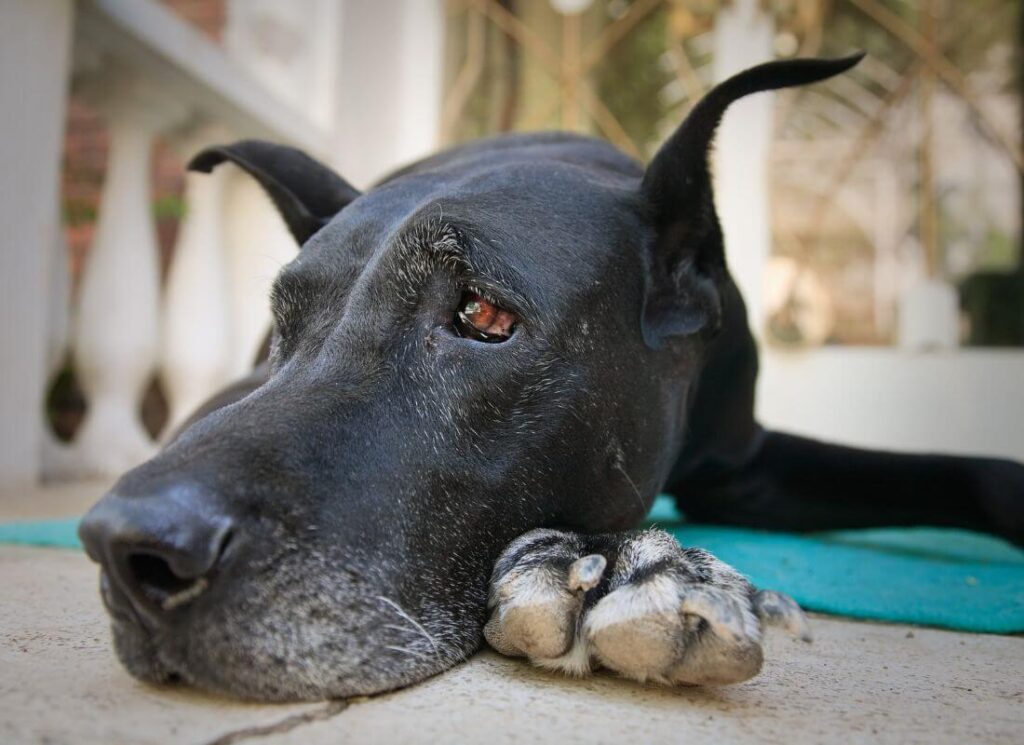
2. Prevent Bloat in Dogs by Managing Meal Times
Managing meals and feeding habits is a key to bloat prevention in dogs.
Your dog should not consider mealtime a speed-eating contest! Encourage slow, stress-free meal times by offering more frequent meals and feeding from puzzles and slow feeder bowls.
I love this stainless steel slow feeder because it holds 4 cups and can be properly washed and sanitized (so you prevent chin acne). The Kong Wobbler is also a huge hit in our house! It’s easy to fill, fun to use and only allows the dog to eat a few kibbles at a time.
Discourage your big dog from inhaling their meals. If you have a dog that also tends to resource guard food (snarling, growling, and snapping), manage the environment to prevent that behavior and the anxiety that comes with it.
Never feed a single large meal, as it increases the risk of bloat. We recommend offering 2-3 meals/day instead.
Because big dogs tend to have sensitive digestive systems, you may find that slow eating and more frequent meals help resolve chronic loose stools, too!
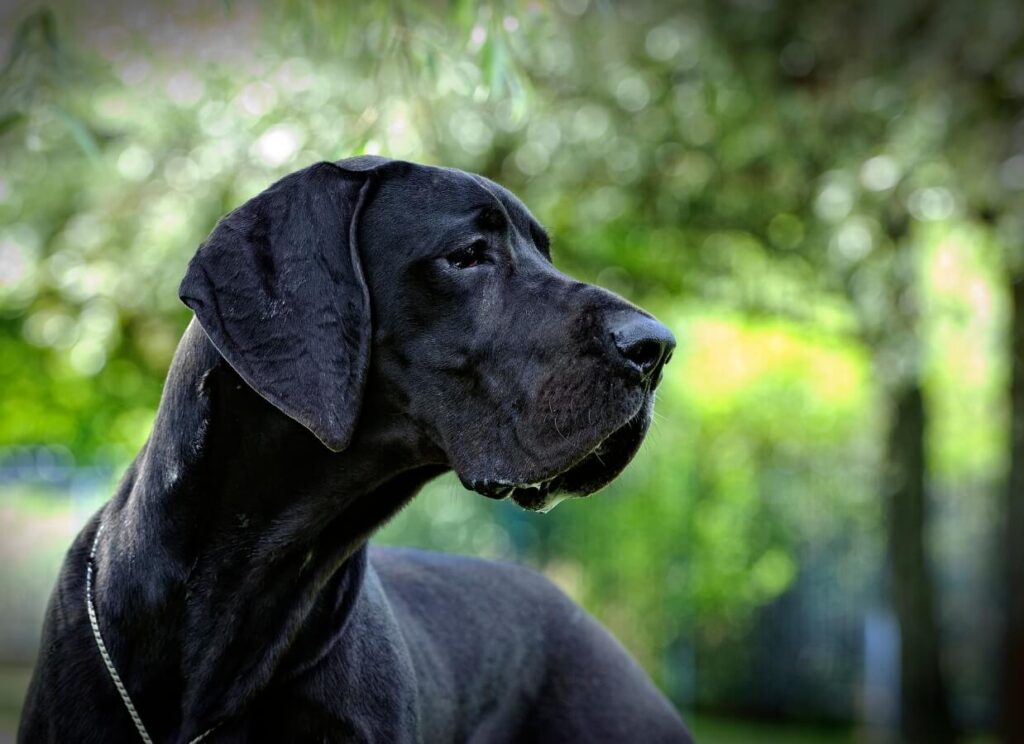
3. Surprising New Science – Movement After Meals is Good!
It’s long been promoted that large and giant breed dogs should rest before and after meals to prevent bloat. It turns out, this might be nothing more than an old wives tale! Worse, resting after meals may have the opposite effect than intended.
A fascinating discovery has emerged that challenges conventional wisdom—movement after meals may play a crucial role in preventing bloat
While the subject is still under scrutiny, early findings suggest that moderate exercise following meals could aid in reducing the risk of bloat by as much as 50%.
It’s important to approach this evolving insight with cautious optimism, acknowledging the need for further research to solidify these claims.
However, I believe this makes a lot of sense. After a big meal, a lot of people will move or walk. This helps the digestive system do its job and move things along. We want our dogs to digest their food, not have it hang out in their stomach pulling on their gastric ligaments.
Rest doesn’t prevent bloat, no matter how much people want to believe it does. Most dogs who present to the veterinarian with bloat/GDV were resting when symptoms began.
Take a common sense approach to this. Don’t run a marathon after a large meal, but there is no need to lock down all movement, either.
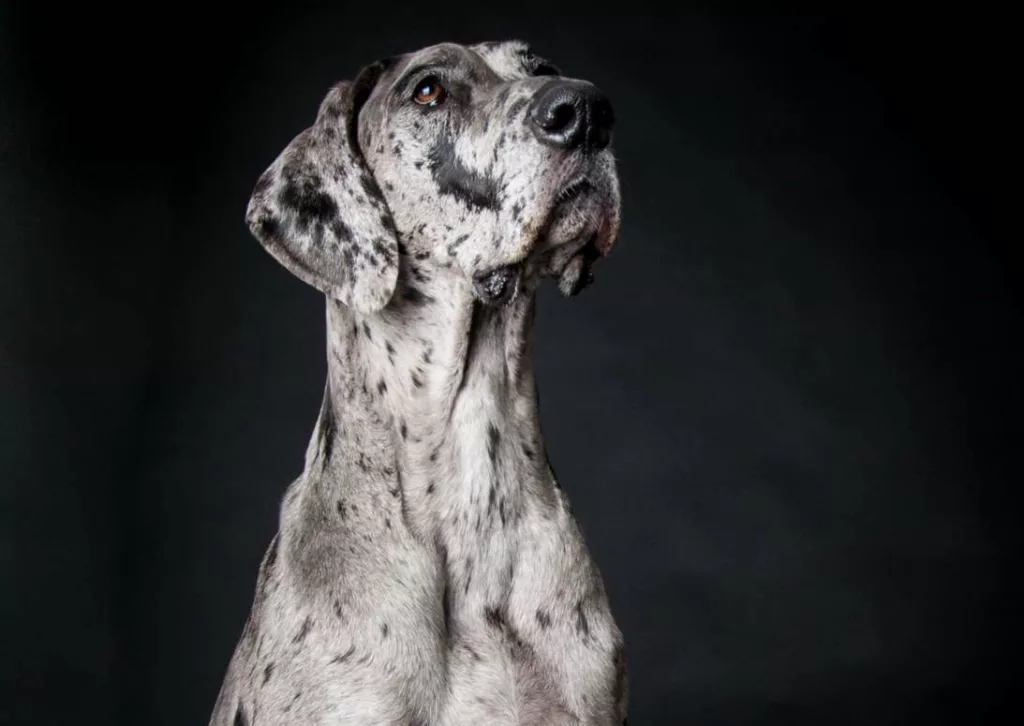
4. Meat Meals & Fresh Foods to Reduce Bloat in Dogs
Research shows that feeding kibble with rendered meat or bone meal as a main ingredient can reduce the risk of bloat. It is also believed that adding canned or fresh foods to the diet plays a key role!
You can read more about that research HERE.
In the pursuit of promoting optimal health for Great Danes and other large-breed dogs, the choice of diet emerges as a critical factor.
For example, Royal Canin Giant Breed dog food was researched and developed to reduce the risk of bloat in dogs over 100 lbs. It is a formula based on a rendered meat and bone meal, with large kibble pieces that encourage slow eating.
Here are links to other foods that are recommended for feeding large and giant breed dogs. Look for a named meat meal in the ingredients list!
- Purina Pro Plan Sensitive Skin and Stomach Large Breed (Salmon based, chicken free)
- Purina Pro Plan Large Breed Shredded Chicken & Rice (Large Pieces & Chicken Shreds!)
- Purina Pro Plan Large Breed Weight Management (Get the weight off)
- Purina Pro Plan Large Breed Bright Mind Age 7+ (for Senior Great Danes)
- Purina Pro Plan Giant Breed (Hard to find, might be discontinued)
- Royal Canin Giant Breed (Amazing for dogs with chronic loose stools, TOP TIER)
- Eukanuba Large Breed (Great for active and sport dogs)
- Purina One Smart Blend Large Breed (Fantastic budget-friendly option)
- Hill’s Science Diet Large Breed Beef & Rice
- Purina Pro Plan 30/20 Sport Beef & Bison
Canned foods and fresh foods can also be added to the diet to promote good digestion and health. While the exact mechanism behind this is unknown, studies do show that dogs fed only kibble are at a higher risk of bloat.
When adding fresh foods, stick to the 90/10 rule. Unbalanced foods must make up 10% or less of the diet. For dogs under age two, 5% or less is a safer ratio.
Most canned food is balanced, so it can make up a larger portion of the overall intake. Just Food for Dogs is also a great way to add fresh foods that are balanced!
For fresh options straight from your kitchen, consider the following:
- Carrots (I love to give my dogs Olewo Carrots!)
- Blueberries
- Sweet Potatoes
- Apples (without seeds)
- Spinach
- Pumpkin
- Green Beans
- Broccoli (in moderation)
- Watermelon (seedless)
- Plain cooked chicken
- Salmon (cooked, boneless, and without seasoning)
- Plain yogurt (in moderation, use sparingly for dogs under the age of 2)
It may be tempting to overdo it with the beautiful fresh foods or to even go all in and start making your pet food in your kitchen. However, we caution heavily against doing this. Most home-cooked diets are nutritionally deficient (or worse, dangerously high in certain minerals and vitamins). This will lead to more health problems than it helps! Read here for more information on homecooked food for dogs.
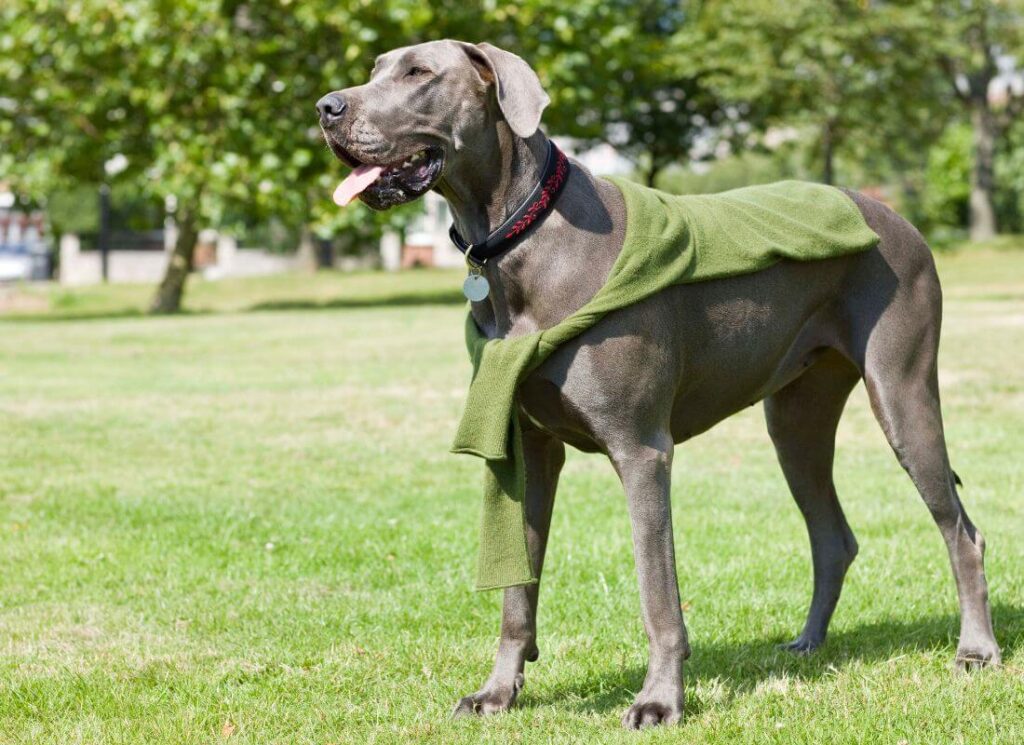
5. Gastropexy & Bloat in Big Dogs
Gastropexy is the single proven method for reducing complications associated with bloat in dogs.
A “Pexy” refers to a surgical procedure in which the stomach is affixed to the abdominal wall. This simple stomach tack serves as a preventive measure against bloat, preventing the stomach from potentially flipping over, a condition known as torsion.
When performed by a skilled veterinarian, this minor yet life-saving procedure aligns with statistically improved outcomes for larger dog breeds, making it a prudent choice for their well-being.
While the procedure may not eliminate the possibility of bloat, it significantly lowers the chances of torsion, providing peace of mind for both dog owners and their beloved, large canine companions. Veterinarians who work in emergency medicine overwhelmingly support this procedure, which should be done at 18-24 months of age.
Consulting with a veterinarian about the potential benefits of gastropexy for specific breeds and individual dogs is always advisable.
It is typically done during routine spay and neuter or dental cleaning surgeries. Work with an experienced veterinarian who has done the procedure many times!
No matter what, always listen to your veterinarian. Enjoy your pet and don’t stress! Bloat is going to happen or it’s not, it’s much more important to know the signs of dog bloat and be ready with emergency funds to treat it.
Unfortunately, you can do everything right and still have a dog experience bloat. Don’t beat yourself up, and don’t stress. Dog’s lives are short compared to ours, and we must enjoy them while they are here with us!
Leave a comment below! Has your dog experienced bloat?



